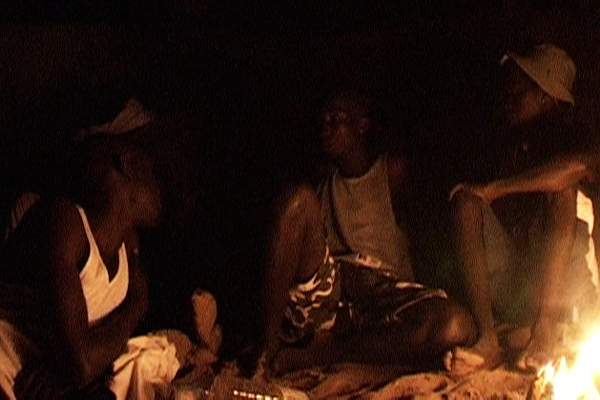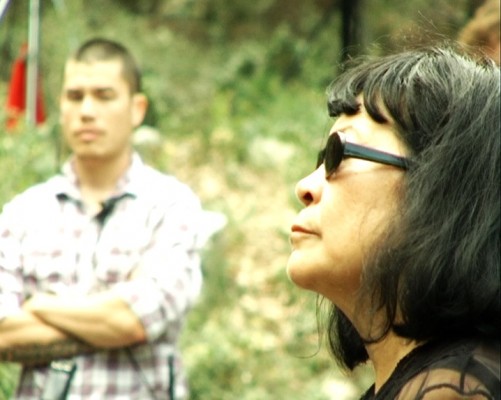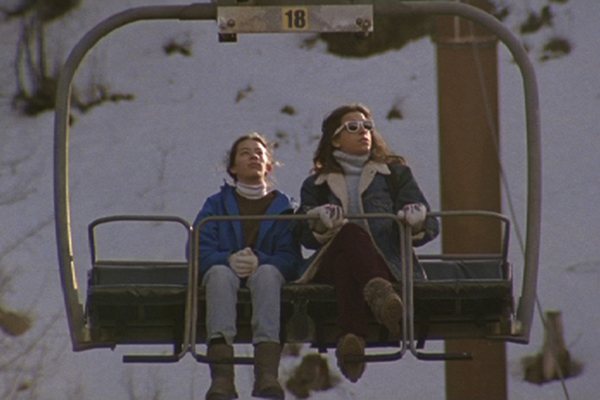Tremors in the Night
"Cinema is magic in the service of dreams." —Djibril Diop Mambéty
"This fever is a nightly invader, that strikes the patient during deep sleep. He jumps off his bed and runs to the bridge. There, he believes seeing beyond the waves, trees, forests, flowered meadows. His joy erupts in thousand exclamations. He experiences the most burning desire to flow into the ocean." —Atlantiques
Furtive and feverish yet bathed in an incandescent tranquility, the films of Mati Diop reside in the realm of the senses. The sly charms of her cinema ebb and flow at their own pace, troubling the very unusual serenity that emerges from the young director's diaphanous images, which hover and hesitate just like the characters they portray. Known increasingly for her trio of award-winning and highly original short films—Atlantiques (2009), Snow Canon (2011) and Big in Vietnam (2012)—Diop first came to light as a non-professional actress playing the stunning, stoic daughter in Claire Denis's 35 Rhums (35 Shots of Rum, 2008), whose rapturous, unforgettable "Night Shift" scene became an instant cinephile fixation; not as euphoric as Denis Lavant's breathless dancing salvo in Beau Travail, but fetish-worthy just the same with its rain-soaked, sexual slow dancing and stealthy, longing gazes. Diop's widely praised performance led to subsequent roles, most recently as a beguiling French prostitute in Antonio Campos's Simon Killer. She's also, as her name reveals, from an august cinephilic family lineage, the niece of legendary Senegalese auteur and poet Djibril Diop Mambéty (Touki Bouki, La Petite vendeuse de soleil) and daughter of jazz musician Wasis Diop, a celebrated sound composer, most notably for the films of Mahamet Saleh Haroun.

Atlantiques
It certainly wouldn't be a stretch to cite the influence of Mambéty or Denis on Diop's own film work, especially with the former's non-linear, semi-experimental narrative storytelling and the latter's focus on the body, choreographed movement, and often quiet, mounting emotional intensity. And yet, Diop has achieved, even before completing a feature, a refreshingly idiosyncratic style, with a personal and intimate approach to themes of identity, desire, migration, and cultural collision that resonate within and among her works. (Two features are on the way: a documentary on the destiny of the actors in Touki Bouki called 1000 soleils and a fiction film about an impossible love between a seafarer and his shore-bound girlfriend, tentatively titled La prochaine fois, le Feu.)
All three films (which have traveled in recent months from London to Vienna and now New York in retrospective showings) function in different modes and have distinct moods. Atlantiques is a fragile telling of a mythic odyssey shuffling fact and fiction, chronology and memory, history and its recitation; Snow Canon is a bigger-budget fictional coming-of-age story about burgeoning female desire based on childhood remembrances filtered through Stendhal; and Big in Vietnam is a film-à-clef that wanders into mysterious, near-somnambulist terrain alongside its errant characters. But all are flushed, hallucinatory worlds that linger in affect and atmosphere long after their brief running times.

Big in Vietnam
Creating indelible microcosms out of tangible places that double as metaphorical and magical landscapes—a flickering campfire in Dakar, a luxury chalet in the Alps, a verdant suburban Marseille that swiftly transforms into an urban, nocturnal trans-continental drift—Diop demonstrates how place resides in physical space as fervently as it does within the limitless expanse of the imagination. Dreamy and desultory, her films proceed like phantasms of the mind, traveling over bodies that are magnetically drawn together, whether for comfort or lust (and especially at the interstice where the two meet), or to access faraway lands that are yearned for, remembered and missed or fancifully concocted ("the life faraway" is tattooed on the arm of the karaoke singer in Big in Vietnam). In other words, Diop's films are nakedly human, peopled by characters who are fearful, frail, consumed by desire and gumption, who interrupt the flow of life by taking risks, by fleeing, by being intuitive, and mostly, by being vulnerable in their solitude.
The mysterious and melancholic Atlantiques, which won a Tiger Award for Best Short film in Rotterdam, is a feverish, timeless dream of a film, with an elliptical, non-linear narrative mirrored by the paucity of its images, which threaten to break apart and dissolve into digital noise and nothingness. Shot in what appears to be very low-grade video (which struggles to represent nightfall), the images emerge and disappear with their sources of light, whether the blistering sun or a crackling campfire. Serigne, a young man speaking in hushed but impassioned tones, describes the mortal stakes of his high-seas pirogue journey from Dakar to Spain as friends debate the trip's worth and the philosophical implications of having a friend die on board. As the crosscutting to his mourning mother and sister attest (along with the small, simple, jagged-edge tombstone erected in his memory, alongside others identical in size and shape), he is that friend, already dead.
Based on real testimony from those who have undertaken or considered such perilous, illegal expeditions, Atlantiques hypnotically renders these attempts at clandestine immigration "at once"? real and fictive, oscillating as if between the borders of Africa and Europe, between today and tradition with an implicit evocation of Géricault's mythic "Raft of the Medusa". "Look at the ocean. It has no borders...no borders," says one of the young men: a caution to be heeded, or an alluring proposition in an increasingly globalized but also heavily policed and anxious world. Of the film, Diop has said: "I chose not to treat immigration as a subject but as an individual and sensitive experience, as a kind of time travel." Sensitive, yes, and strangely ephemeral in its gauziness, but Atlantiques is also bewitchingly sensual with glistening bodies, intense and smoldering (even grief-stricken) female gazes, and a trance-like, morose and ominous soundtrack. The music kicks up as the concluding close-up of a light tower's massive Fresnel lens, with its prismatic color play and its watery impressions refracting from the glass surface, fill the screen, turning around and around as the music loops in on itself, cyclical, eternal.

Snow Canon
A world away from the burnished tone-poem aesthetic of Atlantiques, Snow Canon, Diop's most conventional and polished film to date was shot in the foothills of the Alps. Routinely (and rashly) referred to as her lesbian fantasy film, Snow Canon retains a charmingly amateurish quality despite being made with a professional crew, including a cinematographer shooting on 35mm. (Diop herself shot Atlantiques and co-shot Big in Vietnam, both on digital.) A tale of a young girl whose desires are projected onto her babysitters, male and female—and who habitually pushes her fluffy bunny, Souci (worry in French), toward her nether regions—the film is derived from a childhood memory of a cool and sexy American babysitter whose ripped jeans and obsessive listening to The Doors left a deep impression on Diop. Vanina (loosely inspired by the protagonist of Stendhal's 1829 novella Vanina Vanini, adapted by Rossellini in 1961) is a pubescent beauty with swollen lids and bee-stung, lips, left alone in her family's chalet while her parents attend a funeral. Bored and sullen, she Skypes with her best friend vacationing in Mexico, mock sunbathing by the fireplace in bikini and shades, and engages in a flirtatious roundelay with Mary Jane, the American au pair landed on her doorstep like an exotic, gravel-voiced curiosity.
As Mary Jane suffers a telephone break-up with her New York boyfriend and Vanina's desire for her swells, they partake in a simulated (or is it?) liaison dangereuse in which roles of power and subordination are traded, the young Vanina exerting control in a time of crisis. But isn't puberty a time of crisis, too? The rules quickly fall away to reveal a strange, almost mystical environment thatat times seems to defy the reality of the situation. With painterly images of Vanina sponging Mary Jane's back as steam rises from the hot tub, or those of a pink-lit grotto in which non-diegetic music (or is it?) contributes an odd galactic fantasy feel, the film, like its characters, succeeds in usurping the climate. Against the preternatural backdrop of the snow-capped mountains, Mary Jane and Vanina emanate heat of all kinds-licking ice cream from a spoon, rubbing tanning lotion on bare skin, gazing lustily (or mock-disapprovingly) at each other. Snow Canon may in fact be Diop's most narratively driven work, but it's also one that belongs to the elements—especially fire and water, and to the spirit of adolescent impulsiveness that embraces the tempting promise of "trouble every day."
Shot before Snow Canon, though appearing later on the festival circuit (and winning Diop yet another Tiger Award at Rotterdam last year), Big in Vietnam is a messier and more successful film. According to Diop, it's the result of a painful and near-aborted project—one that finally emerged through an arduous and uncertain period of editing. Traces of the filmmaker's hesitations can be felt in the film, a sort of cinematic pentimenti that inadvertently acknowledges authorial uncertainty transcending the film-à-clef structure. In a lush forest on the outskirts of Marseille, Henriette, a French-Vietnamese director, is shooting an adaptation of Les Liaisons dangereuses when her Valmont abruptly takes flight into the forest (to Mozart's L'ho perduta, no less!). Unable to cope, she walks off the set, leaving the production in the unsteady hands of her son; as she meanders through the busy port city she's drawn into an unexpected emotional entanglement that reminds her of home. As the film-within-a-film soldiers on, and Valmont continues to roam further and further away, Henriette, in a disarmingly sensual scene of karaoke, recognizes a shared sense of longing in a sexy, chisel-faced duet partner.
As the two stroll in silence like somnambulists headed toward a bright, over-exposed infinity (the sea is calling), they are followed by an awkward observational point of view, alternating between tight, intimate corporeal close-ups and unusual overhead tracking shots, taken from a distance and strangely sibylline. As the shot progresses, it becomes apparent that the camera is riding the beachfront Ferris wheel while the pair wanders amid sunbathers as if in a parallel dream world. As with so many of Diop's characters, their searching perambulations are shown to be temporary ruptures from the cycles and patterns of life. With the rotating Fresnel lens in Atlantiques, the conveyor belt ski lift in Snow Canon, and the fairground ride in Big in Vietnam, Diop hints at a grand, governing force; she's drawn to those who dare—or, in some cases, who simply must—step outside those invisible boundary lines. There, the unexpected might just shed some light on what it is we're doing here in this unfathomable, captivating world.
![]()
LATEST ARTICLES
-20140814-173707-thumb3.jpg)
Fighting Words
by Imogen Sara Smith
posted August 12, 2014

Fighting Words, Part 2
by Imogen Sara Smith
posted August 20, 2014

On the Margins: The Fil…
by Andrew Chan
posted August 12, 2014

Robin Williams: A Sense…
by David Schwartz
posted August 12, 2014
 Tremors in the Night
Tremors in the Night
KEYWORDS
Mati Diop | Big in Vietnanm | Atlantiques | Snow Canon | Djibril Diop Mambéty | Claire Denis | First LookTHE AUTHOR
Andréa Picard is a Toronto-based curator and writer who programs for the Toronto International Film Festival and writes a regular column for Cinema Scope magazine.
More articles by Andréa Picard
